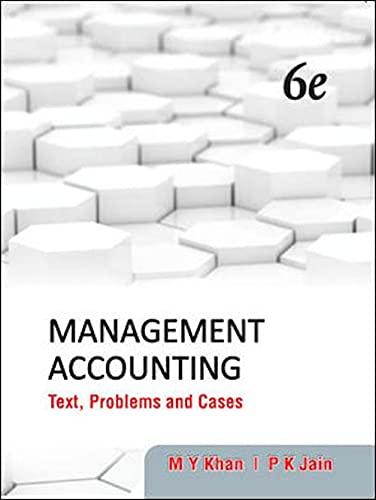4-2 Allocation, Department Rates, and Direct-Labor Hours Versus Machine Hours The Amos Manufacturing Company has two producing departments, machining and assembly. Mr. Amos recently automated the machining department. The installation of a CAM system, together with robotic workstations, drastically reduced the amount of direct labor required. Meanwhile, the assembly department remained labor intensive. The company had always used one firm-wide rate based on direct-labor hours as the cost-allocation base for applying all costs (except direct materials) to the final products. Mr. Amos was considering two alternatives: (1) continue using direct-labor hours as the only cost-allocation base, but use different rates in machining and assembly, and (2) using machine hours as the cost-allocation base in the machining department while continuing with direct labor hours in assembly. Budgeted data for 20X1 are as follows: Machining Assembly Total Total cost (except direct materials) $575,000 SS05,000 S1.080,000 Machine hours 90,000 90,000 Direct-labor hours 12,500 37.500 50.000 *Not applicable. 1. Suppose Amos continued to use one firm-wide rate based on direct-labor hours to apply all manufacturing costs (except direct materials) to the final products. Compute the cost-application rate that would be used. 2. Suppose Amos continued to use direct labor hours as the only cost-allocation base but used different rates in machining and assembly a. What's the cost application rate for machining. b. What's the cost-application rate for assembly 3. Suppose Amos changed the cost accounting system to use machine hours as the cost-allocation base in machining and direct Tabor hours in assembly a. Compute the cost application rate for machining, and b) Compute the cost-application rate for assembly 4. Three products use the following machine hours and direct labor hours: Machine Hours in Machining Direct-Labor Hours in Machining Direct-Labor Hours in Assembly 13.5 Product A Product B Product C 11.0 17.0 13.0 2.9 a. Compute the manufacturing cost of each product (excluding direct materials) using one fimm-wide rate based on direct-labor hours. b. Compute the manufacturing cost of each product (excluding direct materials) using direct-labor hours as the cost allocation base, but with different cost-allocation rates in machining and assembly c. Compute the manufacturing cost of each product (excluding direct materials) using a cost-allocation rate based on direct-labor hours in assembly and machine hours in machining. d. Compare the results in requirements 4a, 4b, and 4c. 4-2 Allocation, Department Rates, and Direct-Labor Hours Versus Machine Hours The Amos Manufacturing Company has two producing departments, machining and assembly. Mr. Amos recently automated the machining department. The installation of a CAM system, together with robotic workstations, drastically reduced the amount of direct labor required. Meanwhile, the assembly department remained labor intensive. The company had always used one firm-wide rate based on direct-labor hours as the cost-allocation base for applying all costs (except direct materials) to the final products. Mr. Amos was considering two alternatives: (1) continue using direct-labor hours as the only cost-allocation base, but use different rates in machining and assembly, and (2) using machine hours as the cost-allocation base in the machining department while continuing with direct labor hours in assembly. Budgeted data for 20X1 are as follows: Machining Assembly Total Total cost (except direct materials) $575,000 SS05,000 S1.080,000 Machine hours 90,000 90,000 Direct-labor hours 12,500 37.500 50.000 *Not applicable. 1. Suppose Amos continued to use one firm-wide rate based on direct-labor hours to apply all manufacturing costs (except direct materials) to the final products. Compute the cost-application rate that would be used. 2. Suppose Amos continued to use direct labor hours as the only cost-allocation base but used different rates in machining and assembly a. What's the cost application rate for machining. b. What's the cost-application rate for assembly 3. Suppose Amos changed the cost accounting system to use machine hours as the cost-allocation base in machining and direct Tabor hours in assembly a. Compute the cost application rate for machining, and b) Compute the cost-application rate for assembly 4. Three products use the following machine hours and direct labor hours: Machine Hours in Machining Direct-Labor Hours in Machining Direct-Labor Hours in Assembly 13.5 Product A Product B Product C 11.0 17.0 13.0 2.9 a. Compute the manufacturing cost of each product (excluding direct materials) using one fimm-wide rate based on direct-labor hours. b. Compute the manufacturing cost of each product (excluding direct materials) using direct-labor hours as the cost allocation base, but with different cost-allocation rates in machining and assembly c. Compute the manufacturing cost of each product (excluding direct materials) using a cost-allocation rate based on direct-labor hours in assembly and machine hours in machining. d. Compare the results in requirements 4a, 4b, and 4c







